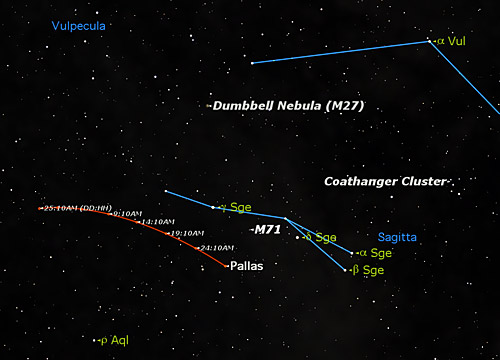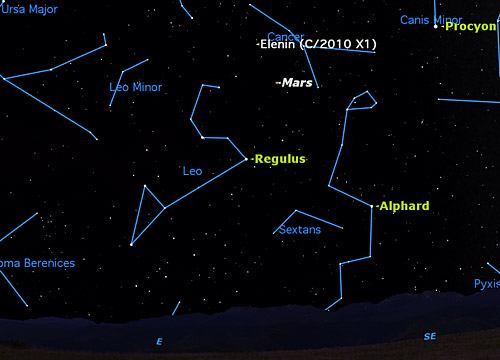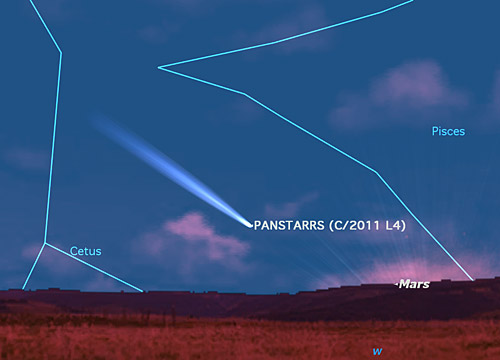By Geoff Gaherty
I’m often asked when the next comet or asteroid will come along, and my answer surprises many people: There are always quite a few asteroids and comets in the sky, but they are mostly faint and require a telescope or at least binoculars to spot.
By default, Starry Night is set to display these asteroids and comets but, because most are faint, you probably don’t know they’re there unless you turn on their labels (under the Labels menu). Do that right now, and I guarantee that you will be amazed! You will also want to turn the labels off again, as they will drive you crazy.
Asteroids
You will probably never see an asteroid with your naked eye—if you do, it may be the last thing you ever see because that would mean the asteroid was too close for comfort!
Asteroids are very small bodies. Now that Ceres has been promoted to being a dwarf planet, the largest asteroid is Pallas, only 524 km. in diameter, and most asteroids are a lot smaller than that. Since most asteroids are located in the “asteroid belt” between the orbits of Mars and Jupiter, so you have a bunch of very small objects which are very far away. The brightest asteroid, Vesta, just barely reaches naked eye visibility close to its opposition.
Let’s digress for a moment to talk about the “asteroid belt.” This is far from being the sea of rocks you may remember from Star Trek or some computer game. In fact, the asteroids in the “asteroid belt” are so far apart that you would require a telescope and Starry Night to spot one asteroid from the next. Did you know that you can move your observing location in Starry Night from the surface of Earth to any other body in the solar system, or any star, for that matter?
If asteroids are so small and far away, how do we choose which ones to look at? I use the Royal Astronomical Society of Canada’s Observer’s Handbook to find out which asteroids are well placed at the present time. It lists all asteroids brighter than 10th magnitude visible during the year. I use this to compile a shorter list of all asteroids brighter than 9th magnitude.
The largest asteroid, Pallas, will be in opposition on July 29. This is not a very favorable opposition, since Pallas will reach only magnitude 9.5. The good news is that it will take place in an interesting part of the sky, in the tiny but bright constellation of Sagitta, the arrow.
As always, Starry Night will pinpoint Pallas’ location from night to night but, with fast moving objects like asteroids and comets, I like to use Starry Night’s Celestial Path feature to plot its daily motion.

This shows Pallas’ path from June 25 to opposition on July 29, a gently curving arc along the south side of Sagitta.
What will you see? Pallas is so far away that it will appear as a 10th magnitude star. However, it is moving against a rich area of the Milky Way, so even watching it for 10 or 15 minutes should show some motion against the background stars in a telescope at moderate magnification, confirming that this is, in fact, a moving asteroid.
While in the area, be sure to check out the three outstanding deep sky objects: the Coathanger Cluster; the best planetary nebula in the sky, the Dumbbell (Messier 27); and the pretty little globular cluster Messier 71.
Comets
As with asteroids, there are always dozens of faint comets scattered all over the sky. However, it’s the occasional bright one that catches our interest. In fact, it was a bright comet, Arend-Roland, that first got me started in astronomy in 1957, and another bright comet, Hale-Bopp, that got me back into astronomy in 1997.
Bright comets are hard to predict in advance, as most are one-time visitors to the inner solar system. There are, however, two interesting comets which will be gracing our skies in the next couple of years.
The First is Comet C/2010 X1 (Elenin) discovered last December by Russian amateur astronomer Leonid Elenin. This comet will make a close approach to Earth, 0.23 au. distant, on 2011 October 16. Present predictions are that it will be just fainter than visible to the naked eye, so binoculars will probably be needed to spot it. It will be sitting right above Mars on October 16 at 6 a.m.

There is a lot of nonsense circulating on the internet about this comet. New age crazies are claiming that it is the mystery planet “Nibiru,” while others say it is a brown dwarf star which will collide with Earth. In fact, it is just an ordinary comet, currently 3 or 4 km. in diameter, which hopefully will sprout a nice little tail around its time of closest approach.
A more interesting comet is expected to put on a spectacular show in a year or two. This is the first major discovery by the Panoramic Survey Telescope and Rapid Response System (Pan-STARRS) in Hawaii.
This comet is predicted to reach 0.9 magnitude on 2013 March 25, making it by far the brightest comet in years. It will be low on the western horizon at sunset on that date, but will swing up higher above the Sun over the next few days. This looks like being the first great comet of the 21st century.

Both these comets are currently in the Starry Night comet database, so you can easily track their progress.
This article was first published in The Starry Night Times, where Geoff Gaherty was a columnist.
Featured photo by Vincentiu Solomon